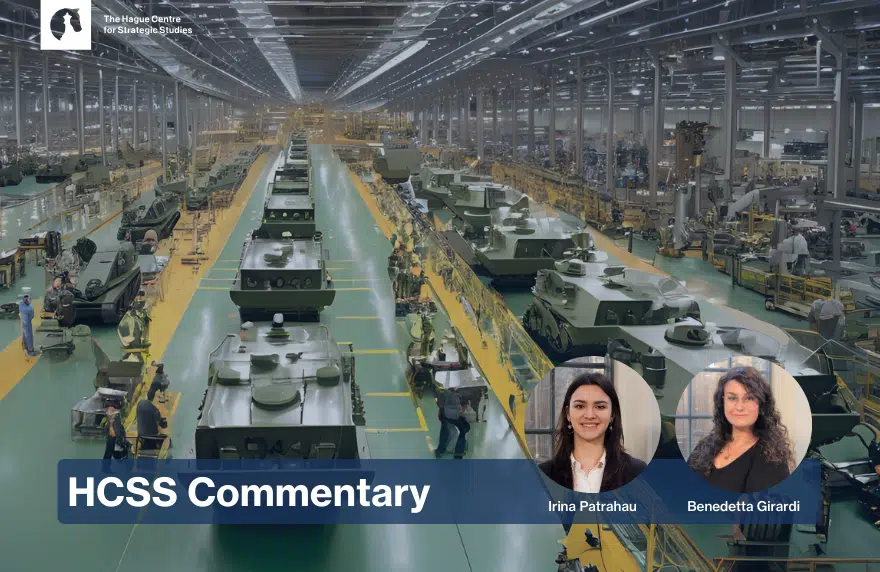Opinion | Europe’s military supply chains are too fragile, fragmented, and opaque for today’s security environment—putting its Rearmament Plan at risk. While policymakers focus on boosting defence investments, a critical blind spot remains: securing the midstream of military supply chains. Without transparency and resilience in sourcing key components, European defence readiness is vulnerable to disruption. Read the latest HCSS op-ed by analysts Irina Patrahau and Benedetta Girardi on why Europe must urgently strengthen its defence supply networks.
European military supply chains are too fragile, fragmented, and opaque for today’s security environment. This may hinder the success of its Rearmament Plan.
The blind spot lies in the midstream: the production of components that serve as critical links between raw materials and system manufacturing.
Amidst increased tensions and geopolitical uncertainties, European military readiness, especially on the eastern side of the Atlantic, has come under scrutiny. European states have since gained strong momentum to revitalize their militaries, pressed by concerns ignited by the Russo-Ukrainian war. Defence investments are a key priority of the Von der Leyen II Commission, emphasized by the ReArm Europe plan. This is also pushed by NATO Secretary General Mark Rutte, who encouraged the Alliance’s members to “turbo-charge [our] defence production and defence spending.”
In response, policymakers are rushing to allocate resources to repairs, modernization efforts, and personnel.
But a crucial aspect has been flying under the radar: securing the supply chains of defence systems. Europe’s military readiness will not be strengthened without addressing its fragile, fragmented and opaque supply chains.
A Blind Spot in Procurement
The beginning and the end of a military supply chain are mostly known. Upstream, the use of materials such as titanium, tungsten, antimony, aluminium, and steel in defence systems is relatively well-documented. Downstream, the major defence manufacturers responsible for assembling frigates, jet fighters or submarines are known and headquartered in NATO countries.
The blind spot lies in the midstream: the production of components that serve as critical links between raw materials and system manufacturing.
A submarine is made up of more than 600,000 components. Defence manufacturers source each of these components from a vast network of suppliers that consists of thousands of companies across the globe.
Many defence suppliers operate in the commercial sector; in other words, defence has to compete with the digital sector or healthcare for components like semiconductors, switches, and lenses.
When it comes to dual-use components, many defence suppliers operate in the commercial sector. In other words, defence has to compete with the digital sector or healthcare for components like semiconductors, switches, and lenses. These dual-use components use raw materials and minerals from a wide range of suppliers, the largest of which being China.
The rest of the components are defence-specific with highly specialized characteristics that require precise engineering and stringent certifications. In turn, these depend on advanced materials: landing gears use special steels, tank armours use titanium alloys, and submarine ball valves use tungsten alloys. Like in the case of dual-use components, the raw materials come from a wide range of suppliers, but go through a diverse range of highly specialized production processes in different countries before being used as advanced materials in the defence sector.
By the time the 600,000 components are integrated to manufacture a submarine, several tiers of contractors have been involved in the process. This extensive and often decentralized sourcing mechanism adds numerous layers of complexity, making it difficult to track the origins and movement of materials and components. As a result, the midstream of defence supply chains becomes highly opaque, introducing bottlenecks that can become single points of failure as well as significant challenges in understanding and mitigating supply risks. A disruption in the supply of materials and components that are critical for a military system can delay production timelines, inflate costs, and weaken overall military readiness. In a conflict situation, this leads to fatal combat failures.
Strengthening Europe’s Defence Supply Chains
Strengthening the ability of the defence industry’s supply chain to anticipate, absorb, and adapt to unexpected disruptions should be a key priority for policymakers.
Two fundamental weaknesses make it difficult for Europe’s defence industries to achieve this goal. First, there is little-to-no mapping by the defence industry of which materials are used in which components or sub-components. Second, and related to this, defence manufacturers do not have a clear view of which actors are involved in procuring components, sub-components and materials.
The future of Europe’s defence sector depends not only on political will, but also on increased insights into supply chains and into future material and component needs.
Without understanding the midstream, even if the production of (upstream) materials in Europe grows or stockpiles are established, (downstream) defence manufacturers will still not be able to directly use these to mitigate a supply disruption.
The future of Europe’s defence sector depends not only on political will, but also on increased insights into supply chains and into future material and component needs. This can be achieved through systematic tracking and forecasting of material and component needs, starting with digital material passports to identify vulnerabilities and extending to a comprehensive assessment of future components’ requirements. The EU, in collaboration with the defence industry, can lead these efforts by establishing shared methodologies and data management systems, ensuring a more secure and resilient supply chain.
The Rearmament Plan comes at a crucial moment for Europe, but procurement is only the tip of the ice-berg —without secure supply chains, even the best military can falter. And in times of intense geopolitical instability, Europe can no longer afford to march forward with blind spots in its defence.
Authors: Irina Patrahau and Benedetta Girardi, March 2025








